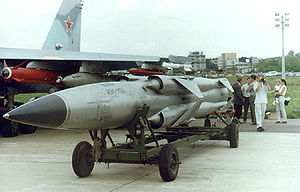- Moskit
-
Moskit 
Type Anti-ship missile Production history Manufacturer MKB Raduga Specifications Weight kg 4,500 kg (9,900 lb) Length 9.745 m (31.97 ft) Diameter 0.8 m (2.6 ft) Warhead 320 kg (710 lb) explosive or 120 kt of TNT fission-fusion thermonuclear Engine Four ramjets (solid fuel rocket on air-to-surface version) Wingspan 2.10 m (6.9 ft) Operational
range120 km (75 mi) Flight altitude 20 m (66 ft) above sea level Speed Mach 3[1] Guidance
systemactive radar Launch
platformnaval ships, fixed-wing aircraft The P-270 Moskit (Russian: П-270 «Москит»; English: Mosquito) is a Russian supersonic ramjet powered cruise missile. Its GRAU designation is 3M80, and its NATO reporting name is SS-N-22 Sunburn. The missile system was designed by the Raduga Design Bureau during the 1970s as a follow up to the SS-N-9 "Siren". The Moskit was originally designed to be ship launched, but variants have been adapted to be launched from land (modified trucks), underwater (submarines) and air (reportedly the Sukhoi Su-33, a naval variant of the Sukhoi Su-27). The missile can carry conventional and nuclear warheads.
The exact classification of the missile is unknown, with varying types reported; this has been due to the secrecy surrounding an active military weapon. It is one of the missiles known by the NATO codename SS-N-22 Sunburn. It reaches Mach 3 at a high altitude and its maximum low-altitude speed is M2.2, triple the speed of the subsonic American Harpoon. When such slower missiles, like the Harpoon or the French Exocet are used, the maximum theoretical response time for the defending ship is 120–150 seconds. This provides time to launch countermeasures and employ jamming before deploying "hard" defense tactics such as launching missiles and using quick-firing artillery. But the 3M82 "Mosquito" missiles are extremely fast and give the defending side a maximum theoretical response time of merely 25–30 seconds, rendering it extremely difficult to employ jamming and countermeasures, let alone fire missiles and quick-firing artillery. The Moskit was designed to be employed against smaller NATO naval groups in the Baltic Sea (Danish and German) and the Black Sea (Turkish) and non-NATO vessels in the Pacific (Japanese, South Korean, etc.), and to defend the Russian mainland against NATO amphibious assault.[2]
Variants of the missile have been designated 3M80M, 3M82 (Moskit M).[3] The P-270 designation is believed to be the initial product codename for the class of missile, with the Russian Ministry of Defense GRAU indices (starting with 3M) designating the exact variant of the missile. The 3M80 was its original model. The 3M80M model (also termed 3M80E for export) was a 1984 longer range version of the missile, with the latest version with the longest range being the 3M82 Moskit M. The ASM-MMS / Kh-41 variant is the air launched version of the missile.
The missile has been purchased by the People's Liberation Army Navy (China) and India.
Contents
Specifications
- Launch range, km:
- min 10
- max (3M-80E/3M-80E1) 120/100
- Missile flight speed: 2,800 km/h
- Missile cruising altitude: 20 m
- Launch sector relative to ship’s lateral plane, ang.deg ±60
- Launch readiness time, sec:
- From missile power-on till first launch: 50 s
- From combat-ready status: 11 s
- Inter-missile launch time (in a salvo), sec: 5
- Launch weight:
- 3M-80E missile 4,150 kg
- 3M-80E1 missile 3,970 kg
- Warhead type penetrator
- Warhead weight, kg 300
- Dimensions, m:
- Length 9.385
- Body diameter 0.8
- Wing span 2.1
- Folded wing/empennage span, m 1.3
Operators
 Soviet Union
Soviet Union- Original developer and primary operator of the Moskit.
 Russia
Russia- Inherited Soviet stocks and production.
 India
India- Bought Moskit to be employed on surface ships.
 People's Republic of China
People's Republic of China- Bought Moskit to be employed on surface ships.
Notes
- ^ http://www.fas.org/man/dod-101/sys/missile/row/moskit.htm
- ^ DTIG: Russian Soviet Naval Missiles
- ^ http://web.archive.org/web/20060430235933/www.edefenseonline.com/default.asp?func=sitereg
References
- FAS report
- Global Security report
- Moskit Online Photoalbum from BSF
- DTIG.org report (PDF)
- "Asia’s Advanced Precision Guided Munitions" (PDF)
- Missile analysis (PDF)
Categories:- Nuclear cruise missiles of Russia
- Anti-ship cruise missiles of Russia
- Anti-ship cruise missiles of the Soviet Union
- Ramjet engines
- Launch range, km:
Wikimedia Foundation. 2010.

